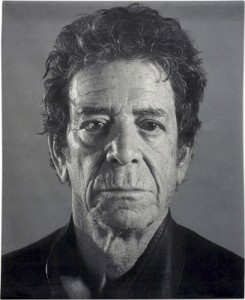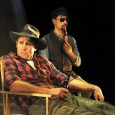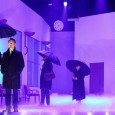Sometimes too much Art seems barely enough. Sometimes too much Art is just too much.
After foolhardily taking in the MCA’s Chuck Close: Prints, Process and Collaboration and the AGNSW’s POP to POPism within hours of each other, I have been left shell shocked by the sheer scale, size and slammin’ power of the experience.
They don’t call them blockbusters for nothing, Jim.
At the entrance to the Museum of Contemporary Art’s Chuck Close show stand two huge portraits – as impassive and monumental as Easter Island moai heads. The two works span time and process: Bob, from 1969 is rendered in greyscale airbrush, cool and smooth; 2012’s portrait of Lou Reed, Lou, is a Jacquard tapestry, bristling with tiny digitally-mapped woven threads.
The two pictures say a lot about Close: they are pictures of pictures, images of photographs; they also show his restless search for media and process, whatever the material or labour-intensive cost involved. The show is subbed Prints, Process and Collaboration and is curated to reveal the mind-warping amount of planning, prep and plain hard graft involved.
The pictures also raise questions about where Close sits in current Art: he has always been a hard one to place, as his work, once aligned simplistically with photo-realism, actually seems closer to minimalism and conceptual art, based on grids of small cells as it is. He works on these small square cells, and, as they disappear, a monumental (photo-realistic) image is revealed.
The range of processes he adopts is staggering – from the (digitally mapped) 19th century Jacquard Loom weave through plate-etching processes such as Spitbite and Mezzotint to traditional Japanese Ukiyo-E woodblock prints. The hours of painstaking labour involved suggest a meditative onanism as much as a saintly work-ethic masochism. This is the man who said “Inspiration is for amateurs; the rest of us just show up and get to work”.
The craft element alone can take your breath away, but of course it is the startling beauty of this work that rivets you to the spot. The coloured self-portraits, broken as if seen through faceted glass, the deep rich earth tones of the square grid images and the delicious grays of the pulp-paper pictures are a spiritual experience, beyond craft.
And each face is coolly inscrutable, giving away no secrets apart from their planes, surfaces and shadows. Close’s hours of process seem to have seeped into the very fabric of these pictures, causing time to slow when you are in their presence.
Enough of this cool stuff: time for something hot!
Up the hill to the Art Gallery of New South Wales’ POP to POPism to see banners shouting Warhol! Sharp! Lichenstein! Haring! hanging along the front of the old girl.
Inside, we are reminded yet again how well the AGNSW does these things: 200 works (mainly killer, some filler) from over 50 lenders worldwide have been brought together and divided up into seven themed areas for bite-sized consumption.
We are also reminded how heavily calorific Pop Art is making each bite-sized chunk a gourmet junk food feast in itself.
‘Swinging London’ has Hockney, Peter Blake (that well-known album cover designer) and Richard Hamilton (that other well-known album cover designer) all in fine form. The art and music that zapped the world from London in the ’60s was unstoppable. That energy is here.
But it was ‘The American Dream’ that set Pop solid in history and stamped its icons into our DNA. Looking at Warhol’s Marilyns, Lichenstein’s comics (with their obsessively hand-drawn half-tone dots) and the super-slick billboard cut-ups of James Rosenquist (originally a pro commercial billboard painter) you are still stunned by their power, electricity and in-your-face sex.
The American works dwarf anything else here. With exceptions such as Martin Sharp or France’s Niki de Saint Phalle (her 1968 ‘Black Beauty’ raises the smile that good Pop should), the Euro and especially Australian work seems almost timid by comparison and less sharply focused. The Annandale Imitation Realist work of Australians Colin Lanceley and Mike Brown cloyingly piles junk on junk, where Robert Rauschenberg’s assemblages of street trash speak with poetry and a dusty grandeur.
Andy Warhol is said to have been “the only artist who truly understood the Twentieth Century”. His work here reinforces that smart idea: his Marilyns are confections of sex and repetition, his electric chair pictures too cool. ‘Electric Chair’ (1965) has a casual, ill-considered cropping–though of course exquisitely considered–and is rendered in a magenta and lime-yellow colourway. The nearby pictures of Jackie Onassis are black on sky blue. It is all the same. We read of an execution and flip the magazine page to see who Jackie has married now. Our feelings are deadened by repetitive sensation. Warhol’s frustrating interview style – all boyish ‘gee’s and ‘I don’t know’s, often misunderstood as irony – mirrored this. He truly understood that history was rolling over us too fast and he nailed it again and again.
Other Americans such as Claes Oldenburg–here represented by a huge ‘soft’ cloth electric fan–and the gutsy hot-rodded Ed Kienholz, say the same thing in their own big, bad American way.
Modern Pop–or the Art that continues Pop’s sexy throb down the years–is represented here by reference to ‘Popism’, a brief local movement and 1982 NGV exhibition, the shining light being the hypersexualised Juan Davila who carried the shock element of Pop aloft in his pornographic vistas.
Of course, the spirit of Pop is most alive today in the marketplace that spawned it–the world of advertising and popular entertainment. References are made every day to Pop Art, the movement that referenced mass marketing and junk TV in the first place.
Sometimes too much Art seems barely enough. Sometimes too much Art is just too much. The work of Chuck Close fills you up with beauty, lovingly made, a strand or cell at a time. The blast of Pop Art at POP to POPism fills you up with electric energy, splashed on and plugged in at high voltage.
Sometimes too much Art is just too much. But if you can handle it, it is worth the wild ride.
Chuck Close: Prints, Process and Collaboration runs until March 15, 2015 at the Museum of Contemporary Art, Circular Quay.
POP to POPism runs until March 1, 2015 at the Art Gallery of New South Wales, Sydney.







